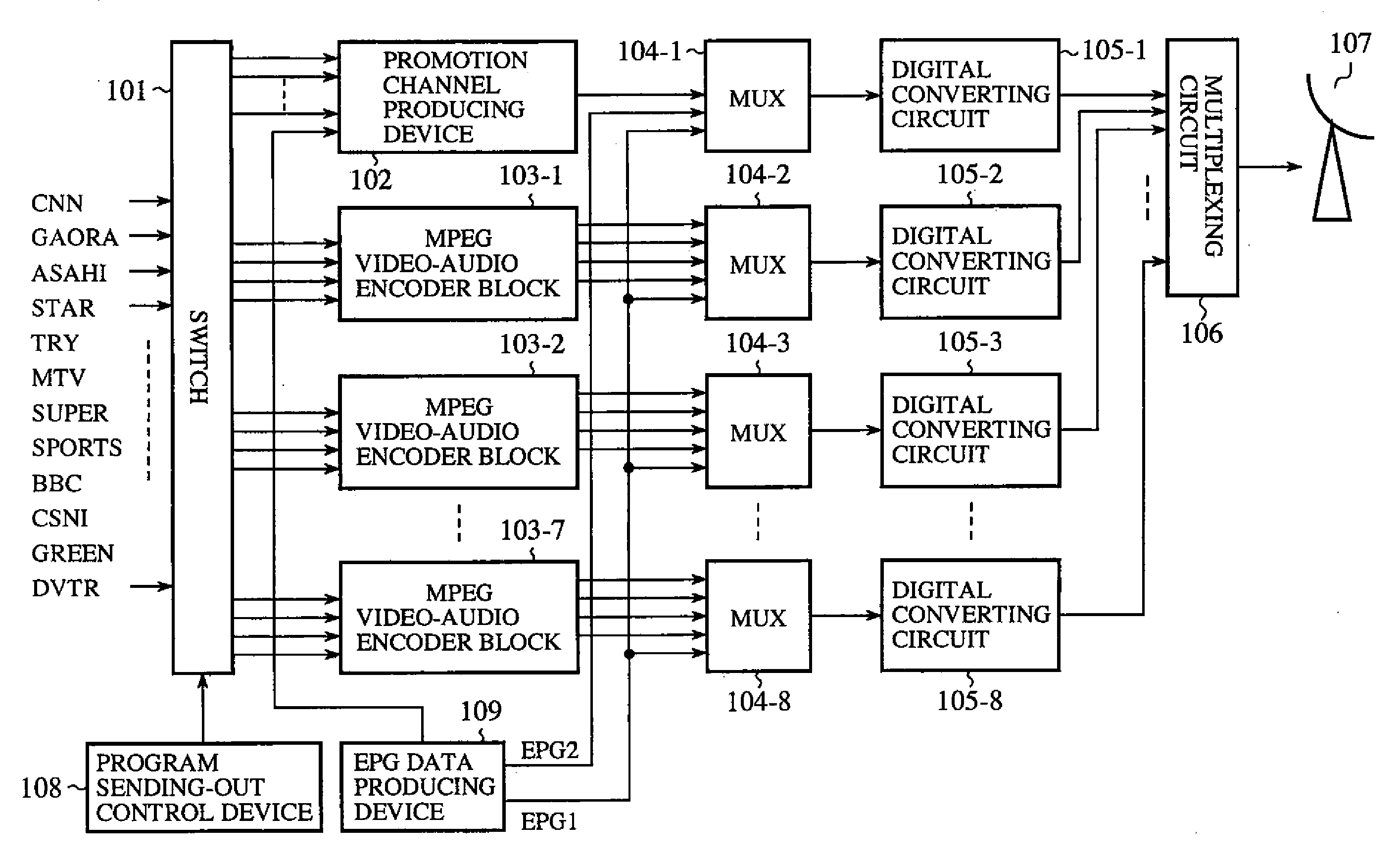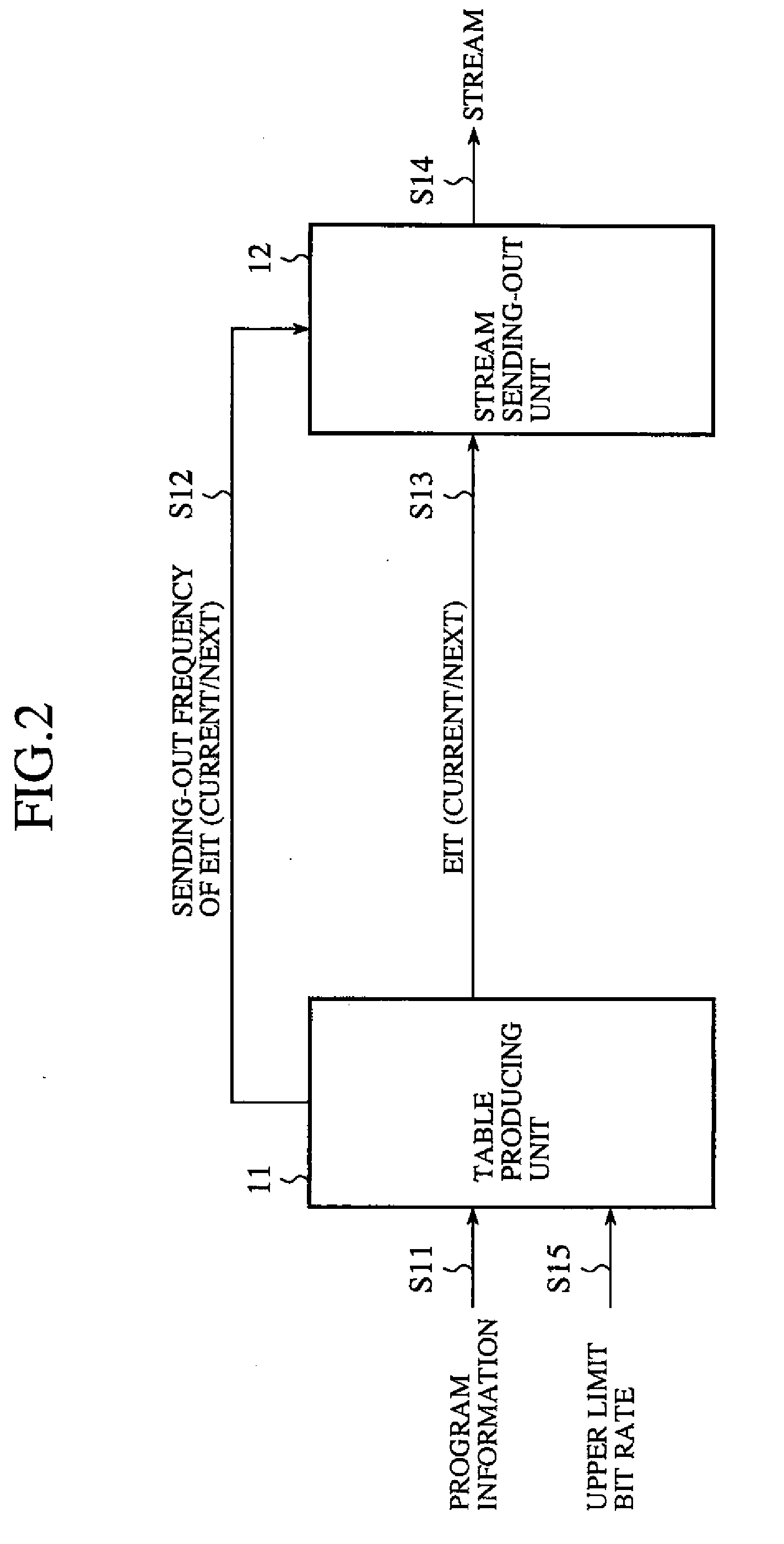Device for sending-out data in which associated data is multiplexed with main data
a data and data technology, applied in the field of data sending out devices, can solve the problems of inability to transmit data signals, short transmission capacity of media data such as video-audio data, and difficulty in selecting a desired broadcast program from a large number of broadcast programs on the receiving side, etc., and achieve the effect of shortening the tim
- Summary
- Abstract
- Description
- Claims
- Application Information
AI Technical Summary
Benefits of technology
Problems solved by technology
Method used
Image
Examples
embodiment 1
[0042]FIG. 2 is a view of the configuration of a data sending-out device according to a first embodiment of the present invention.
[0043]In FIG. 2, 11 indicates a table producing unit. In the table producing unit 11, program information S11 is referred, and the program information S11 is transformed into a type of tables of a transmission format which is prescribed in standards of Advanced Television System Committee (ATSC) of U.S.A or in standards of Association of Radio Industries and Businesses (ARID) of Japan. 12 indicates a stream sending-out unit. In the stream sending-out unit 12, the type of tables produced in the table producing unit 11 are transformed into a format of a bit stream (hereinafter, called a stream) and is sent out.
[0044]Program information prescribed in standards of ARIB of Japan is initially described. “Table” is an information unit of the program information, and there are many types of tables respectively corresponding to a type of information. For example, ...
embodiment 2
[0054]In the first embodiment, the sending-out frequency of the types of tables is determined in the table producing unit 11 according to the restriction of the upper limit bit rate S15. In a data sending-out device according to a second embodiment, the restriction of the upper limit bit rate S15 is satisfied by adjusting an amount of information in each table. The data sending-out device according to the second embodiment will be described below.
[0055]In each EIT, information associated with a program such as “broadcast start time” of the program, “broadcast duration period” of the program, “program name”, “brief description” of the program and “detailed description” of the program” is stored to provide the information associated with the program for viewers. In this case, the information of “broadcast start time”, “broadcast duration period” and “program name” is indispensable, and the importance of the information of “brief description” and “detailed description” is comparatively...
embodiment 3
[0058]In the first and second embodiments, the sending-out frequency S12 and / or the amount of information in one type of tables are adjusted, and the stream sending-out satisfying both the upper limit bit rate S15 and the lower limit value of the sending-out frequency of the type of tables is performed. However, in a third embodiment, as to the sending-out of a plurality of types of tables, “priority order or priority level” (hereinafter, called priority) is set for each type of table, and the sending-out frequency of each type of tables is adjusted according to the priority of the type of tables to perform the stream sending-out satisfying the upper limit bit rate S15. This data sending-out device according to the third embodiment will be described below.
[0059]FIG. 3 is a view of the configuration of a data sending-out device according to the third embodiment of the present invention.
[0060]In a table producing unit 21 according to the third embodiment, a plurality of types of table...
PUM
 Login to View More
Login to View More Abstract
Description
Claims
Application Information
 Login to View More
Login to View More - R&D
- Intellectual Property
- Life Sciences
- Materials
- Tech Scout
- Unparalleled Data Quality
- Higher Quality Content
- 60% Fewer Hallucinations
Browse by: Latest US Patents, China's latest patents, Technical Efficacy Thesaurus, Application Domain, Technology Topic, Popular Technical Reports.
© 2025 PatSnap. All rights reserved.Legal|Privacy policy|Modern Slavery Act Transparency Statement|Sitemap|About US| Contact US: help@patsnap.com



